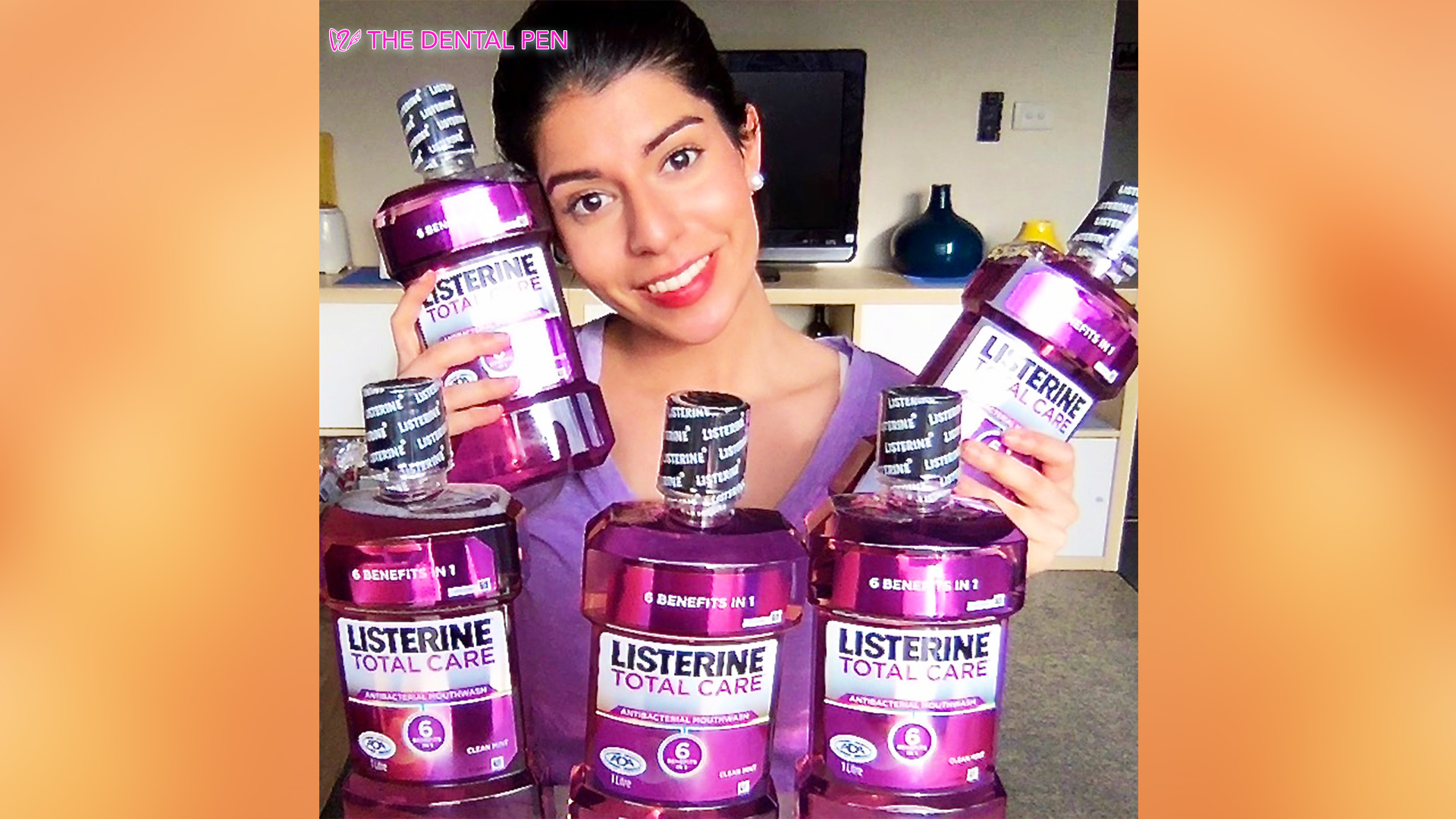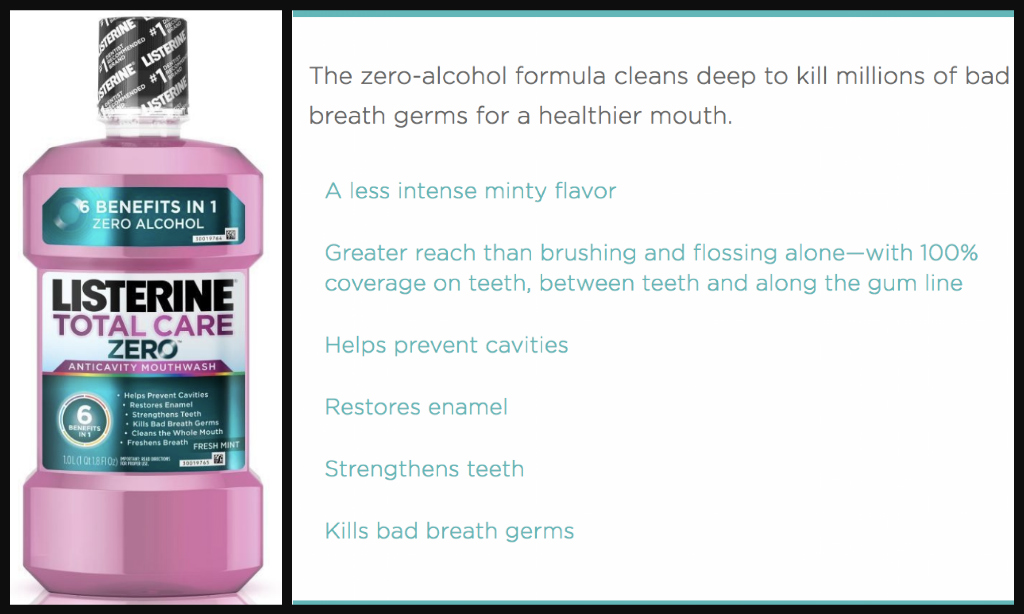Listerine Linked to Oral Cancer?!

Do you use Listerine after you brush your teeth, to get that "fresh mouth" feel? If so, you're using it at the wrong time and actually decreasing the benefits of your toothpaste.
But here comes the jaw-dropping information, studies have shown that certain types of Listerine mouthrinses can actually increase your risk of ORAL CANCER![1]
Growing up, I was always under the impression that mouthrinses (Listerine) were essential in my oral hygiene regime. Little did I know that a decade later, I would come across a single father of 3 daughters, using alcohol-containing Listerine multiple times a day to get rid of his bad breath after smoking a cigarette…would receive the devastating news, "You've been diagnosed with oral cancer". Smoking combined with alcohol-containing mouthrinses increased his risk of acquiring oral cancer by over 9 times![2]
"When only cancers of the oral cavity, pharynx and larynx were considered, then the use of an alcoholic mouthwash twice daily increased the chance of acquiring cancer by over nine times (OR 9.15) for current smokers, over five times for those who also drank alcohol (OR 5.12) and almost five times for those who never drank alcohol"
Research
For decades, Listerine has been one of the most popular mouthrinses in the world. However, its ingredients went under the microscope not too long ago, and a nasty discovery was uncovered - its alcohol levels! Surprisingly, the discovery made very little to no impact on Listerine's popularity, because they have a huge advertising budget and strategic marketing tactics.
I am sure it's common knowledge that smoking and alcohol are linked to oral cancer, but what about alcohol-containing mouthwashes – now that's a controversial topic.
Acetaldehyde, a toxic by-product of alcohol, is known to cause cancer.[3] Even though most of the alcohol metabolism takes place in the liver, there is evidence that it can also take place in your mouth during social drinking. [4,5]
However when you drink socially, you simply sip on the alcohol and immediately swallow it. Whereas with alcohol-containing mouthrinses (Listerine), you tend to swish it around your mouth for a few minutes prolonging the alcohol exposure time to your mouth.
Many studies have shown that long exposure and high concentrations of alcohol in mouthrinses have negative effects in the mouth and can cause, mouth ulcers, gingivitis, pain, epithelial detachment, keratosis, and diffuse white oral lesions. [2,6,7]
Is Listerine Essential in your Oral Hygiene Regime?
The simple answer is, NO. Most people associate the 'burning feeling' after using Listerine with 'clean' and 'freshness', when it really should be associated with 'unnecessary alcohol exposure'.
Let me give you an analogy that might be more relatable: if your dermatologist recommended that you start using a cream, which will help reduce your acne but also increase your chances of getting skin cancer…would you still use it?
So my recommendation on Listerine mouthrinses? Ditch them. To prevent bad breath, cavities, and gum disease, simply brush your teeth twice a day, floss, and chew sugar-free gum!
However, after reading everything above, if you are still keen on using Listerine mouthrinses, then the remainder of this article is for YOU.
Loyal Listerine Users, Which Listerine Mouthrinse Should You Buy?
I just want to start off by saying that dentists rarely recommend Listerine to their patients for every-day use. According to many research studies its efficacy and benefits are quite low. [8]
Thus, the following advice about which Listerine product to buy is only for people who have become accustomed to using Listerine mouthrinses every day and absolutely need it in their oral hygiene routine.
So here's the advice: buy Listerine products that contain ZERO alcohol. They actually advertise it as Listerine ZERO.

However, as previously mentioned, its effectiveness is highly questionable. This is evident by the subtle change Listerine made in advertising the two products. You'll notice that alcohol-containing Listerine uses the slogan, "Kills 99.9% of germs", whereas Listerine with ZERO alcohol uses the slogan, "Kills millions of germs"…but the truth is, you have a lot more than a "million germs" in your mouth, hence why they removed the percentage. Very strategic advertising.
Best Time to Use Listerine ZERO?
Listerine ZERO should not be used as a substitute for toothbrushing and flossing, and it certainly shouldn't be used immediately after toothbrushing. Here's the reason why:
Your toothpaste contains approximately 1000-1500ppm (parts per million) of fluoride, which is well known for its protective properties against dental caries (cavities). On the other hand, Listerine mouthrinses only contain about 200ppm of fluoride, thus, making it less protective than your toothpaste. So, if you brush your teeth with toothpaste, you're better off leaving 1500ppm of protective fluoride on your teeth instead of rinsing it away with a lousy 200ppm.
So when is the best time to use Listerine Zero? In between your meals, when a toothbrush and toothpaste aren't easily accessible. Also, swishing it around your mouth more vigorously will increase the chances of you disturbing the biofilm that sits on your teeth and can house bad bacteria.
Important Take-Home Messages
1) Alcohol-containing Listerine mouthrinses increase risk of oral cancer. [1].
2) Listerine mouthrinses are NOT essential for everyday use to maintain good oral health.
3) For loyal Listerine users: Invest in Listerine ZERO (no alcohol) & use it in between meals.
References
[1] McCullough, M. J., & Farah, C. S. (2008). The role of alcohol in oral carcinogenesis with particular reference to alcohol‐containing mouthwashes. Australian dental journal, 53(4), 302-305.
[2] Guha N, Boffetta P, Wunsch Filho V, et al. Oral health and risk of squamous cell carcinoma of the head and neck and esophagus: results of two multicentric case-control studies. Am J Epidemiol 2007;166:1159–1173.
[3] IARC Monographs. Re-evaluation of some organic chemicals, hydrazine and hydrogen peroxide. Proceedings of the IARC Working Group on the Evaluation of Carcinogenic Risks to Humans. Lyon, France, 17–24 February 1998. IARC Monogr Eval Carcinog Risks Hum 1999;71 Pt 1:1–315.
[4] Dong YJ, Peng TK, Yin SJ. Expression and activities of class IV alcohol dehydrogenase and class III aldehyde dehydrogenase in human mouth. Alcohol 1996;13:257–262.
[5] Seitz HK, Matsuzaki S, Yokoyama A, Homann N, Va ̈ keva ̈ inen S, Wang XD. Alcohol and cancer. Alcohol Clin Exp Res 2001;25:137S–143S.
[6] Bernstein ML. Oral mucosal white lesions associated with excessive use of Listerine mouthwash. Report of two cases. Oral Surg Oral Med Oral Pathol 1978;46:781–785.
[7] Bolanowski SJ, Gescheider GA, Sutton SV. Relationship between oral pain and ethanol concentration in mouthrinses. J Periodontal Res 1995;30:192–197.
[8] Siegrist, B. E., Gusberti, F. A., Brecx, M. C , Weber, H. P & Lang, N. P (1986) Efficacy of supervised rinsing with chlorhexidine di- gluconate in comparison to phenolic and plant alkaloid compounds. Journal of Periodontal Research 21. Supplement 16. 60-73.








